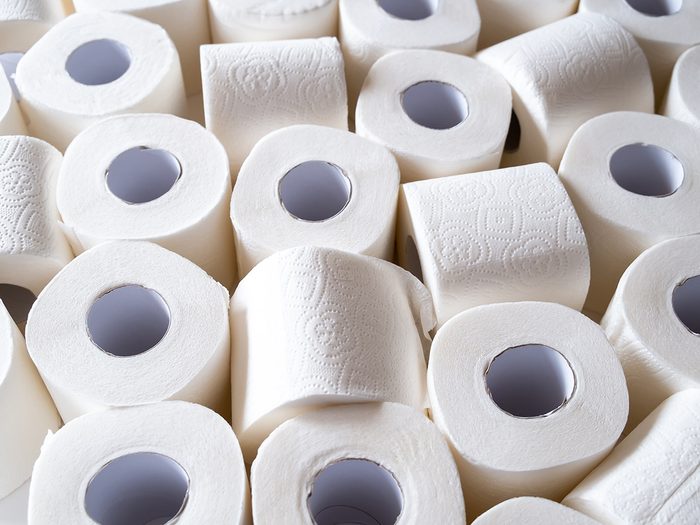This Is Why You Should Rethink Your Toilet Paper Purchases

You can’t wipe out climate change with eco-friendly toilet paper alone, but some kinds are better for the environment than others.
Bog roll. Loo paper. Toilet tissue. Whatever you call it, the average Canadian goes through 83 rolls of it a year. But where does TP come from, and how does it impact our ecosystem?
(Related: 4 Refillable Bathroom Products That Help Keep Plastic Out of Landfills)
The perforated roll you know and love is a relatively recent invention: Descended from more than 1,400 years of Chinese tradition of using paper to clean up your business, it was patented in the U.S. in the late 1800s as a way to “prevent waste.” Later upgrades bragged of being splinter-free, and from the ’50s through the ’80s stylish shoppers could coordinate their bathroom decor with dyed paper in shades like Green Mist or Peach Blush.
These days, it seems, backsides are made of more tender stuff: Companies compete to provide the softest offering possible.
Chances are, the fibres your favourite TP is made from come from “previously unlogged” Canadian forests, and not from tree plantations, says Greg Higgs, director of research and investigations at the Stand.earth Research Group. “Virgin forests produce better fibre,” he says, which translates to a cushier feeling on the tushy.
The majority of pulp comes from Canada’s largest forest ecosystem, the boreal forest. Trees are felled, prepped and chipped, then cooked up with chemicals into a malleable fibre that’s cleaned, bleached, pressed, rolled and cut. Large-scale logging in the boreal makes life precarious for caribou, hares, owls and other inhabitants, and releases carbon into the atmosphere that we’d be better off leaving where it is.
But there is a better way.
The bottom line on what to buy? Higgs says the best pick is any brand made of 100-percent post-consumer recycled fibre. The next best is “tree-free” rolls made of bamboo, which is actually a grass, and is shipped from Asia. The less toilet tissue you use, the less logging is needed. So maybe it’s finally time to install that bidet.
(Related: Why Going to the Bathroom “Just in Case” Is a Bad Idea)
Here are seven more toilet paper facts to ponder on the porcelain throne.
1. Doing Your Business
Canadian toilet paper sales brought in US$1.34 billion in 2022, accounting for almost 375 million kilograms of the soft stuff.
2. History Lesson
Corncobs, rope ends and ripped-up almanacs: Options for wiping have been creative and diverse over the years. One to still consider today is the soft, large leaves of the invasive mullein plant—they’re great for that composting toilet at the cottage, though we don’t recommend you flush them in a regular toilet.
3. Deuce Sleuth
While many companies claim that their TP is 100-percent recycled, they could be using in-factory offcuts from non-recycled rolls. The trick is to look for the phrase “post-consumer,” which means it’s made from the paper you toss in your blue bin. It’s quite hard to find in Canada, but increased demand will help boost supply, so be loud and proud about your loo-paper preferences.
4. Papering Over the Problem
Brands that boast about their carbon offsets and carbon neutrality are likely engaging in some serious greenwashing. Look for that “post-consumer” label instead.
5. Forest for the Trees
Tree plantations are created when companies hire tree planters to fill in after huge clearcuts. These plantations have their uses, but they’re typically monocultures, which is very different from a natural forest ecosystem. Unlogged forests are worth protecting because they host more biodiversity and store more carbon than their newly planted cousins.
6. Wiped Out
The Canadian boreal forest stores twice as much carbon as the world’s oil reserves, and keeping that carbon in the forest and out of the air is one key to fighting climate change. But approximately one million acres of this forest are clearcut every year.
7. Are bidets better for the biosphere?
All signs point to yes—well, almost. If you live in a drought-prone area, that half litre (the typical amount used in a single bidet wash) could add up to a serious drain on local water reserves. But producing TP takes huge amounts of water and energy, too—some 140 litres and 1.3 kWh per roll. So if you prefer that freshly washed feeling from a bidet, go for it.




